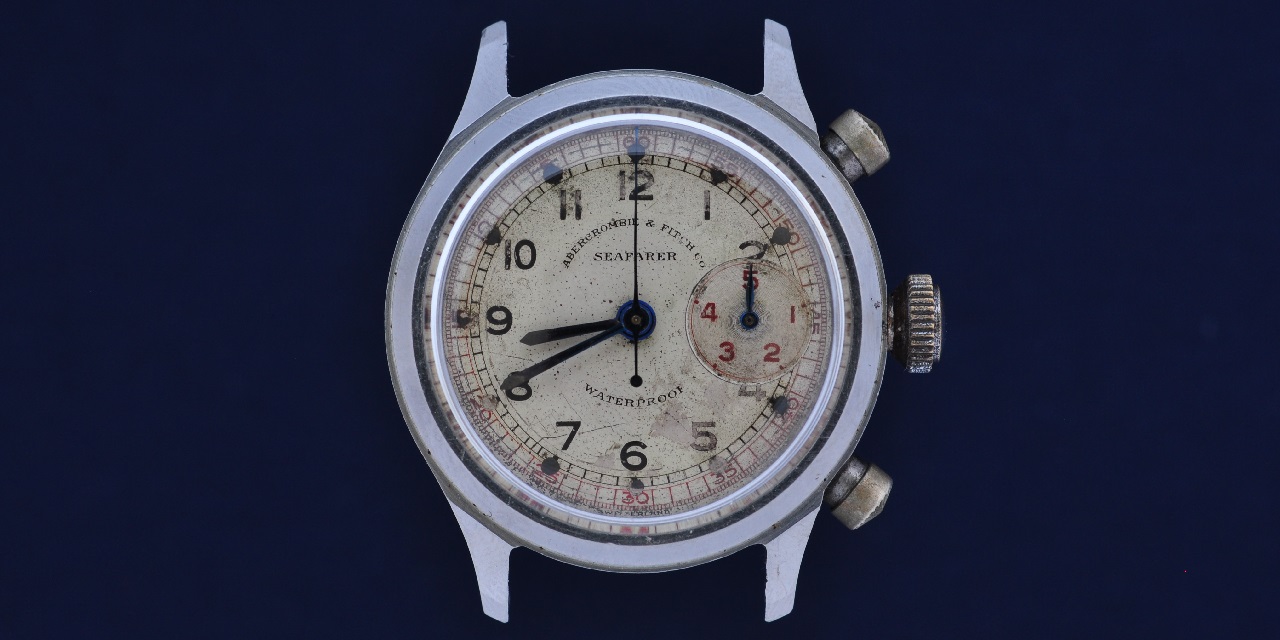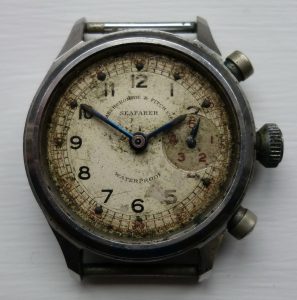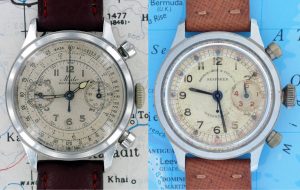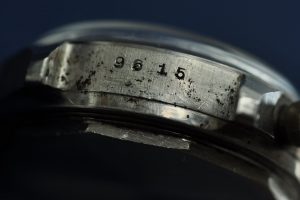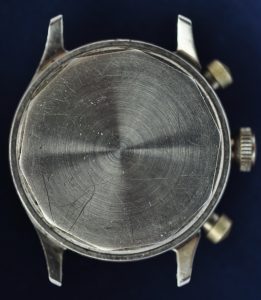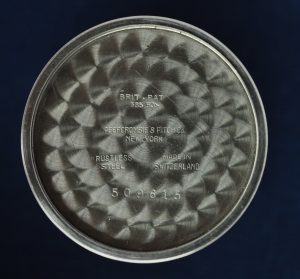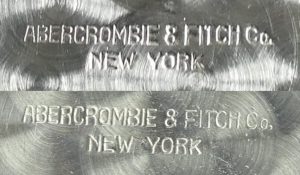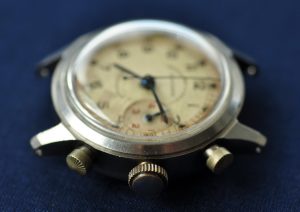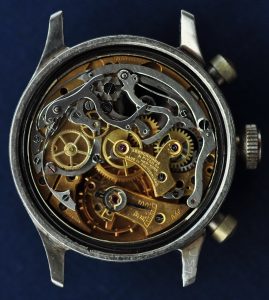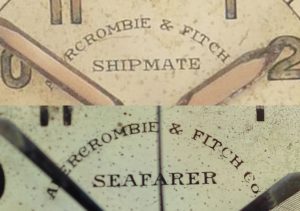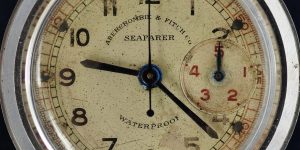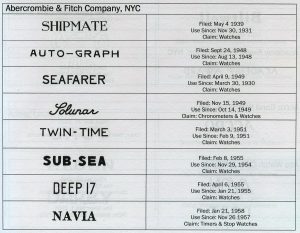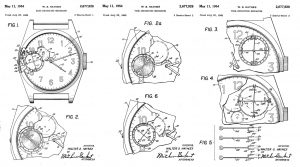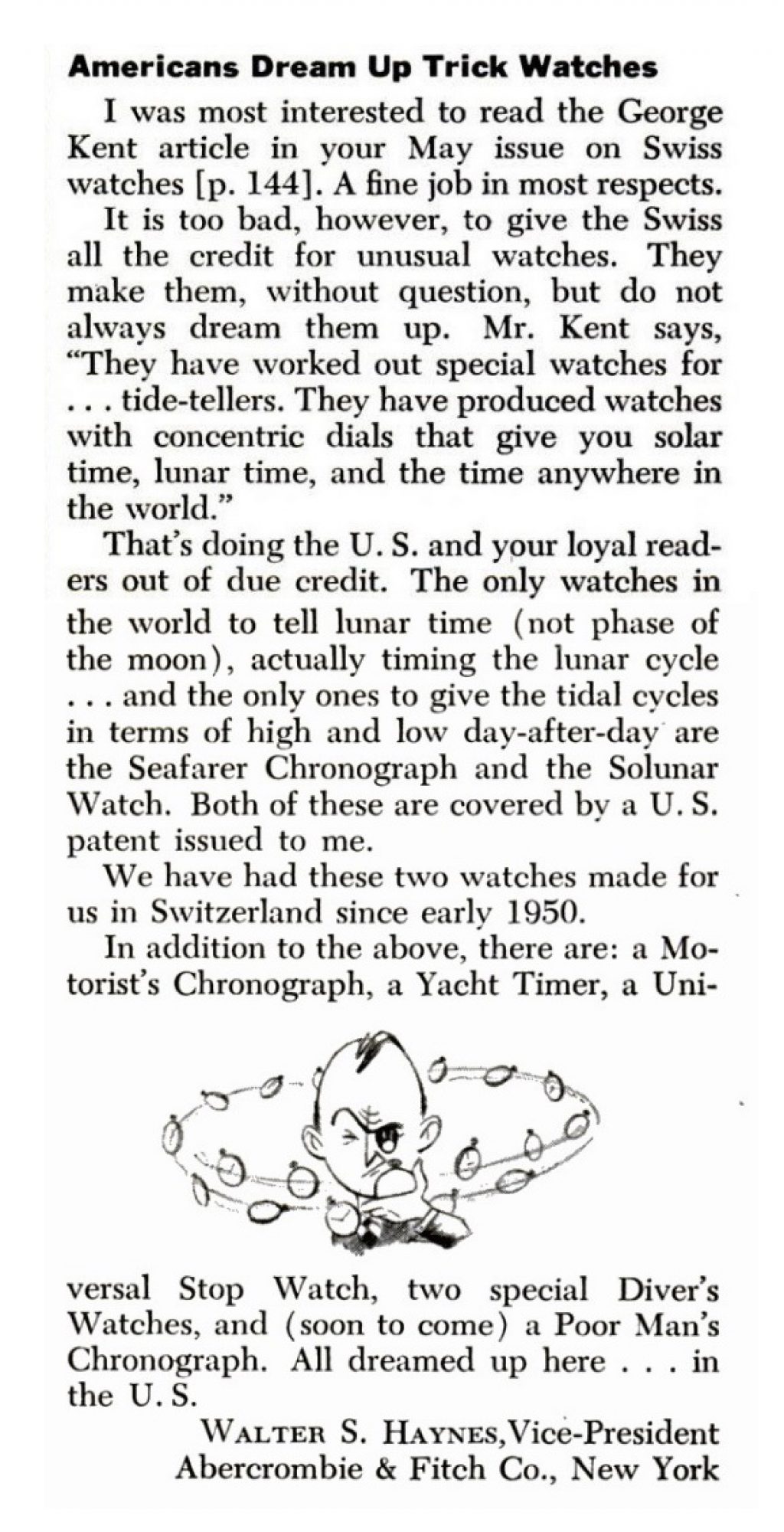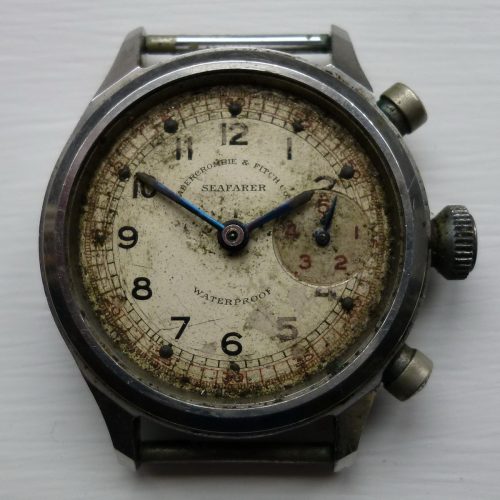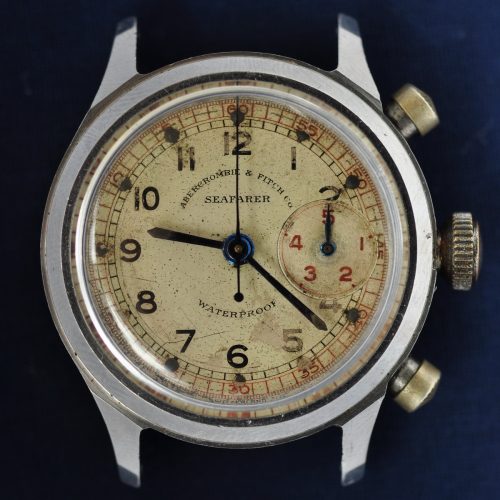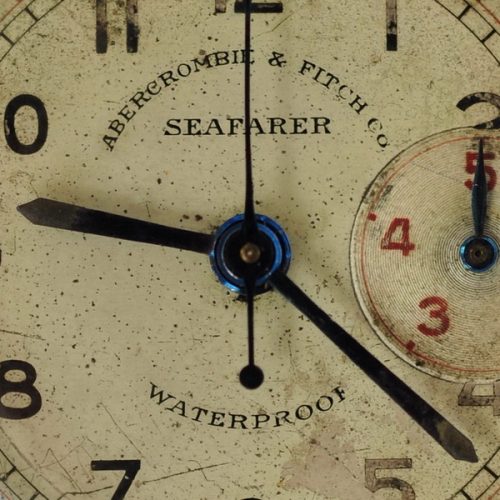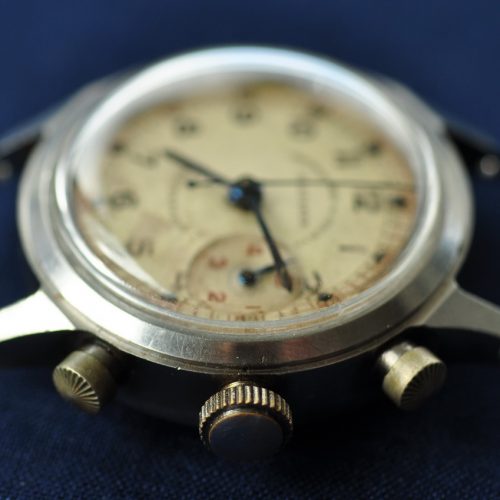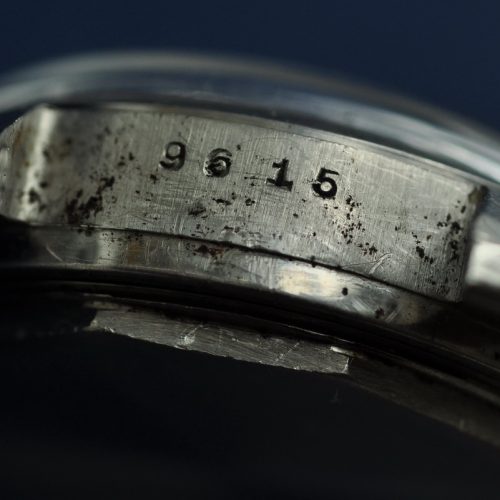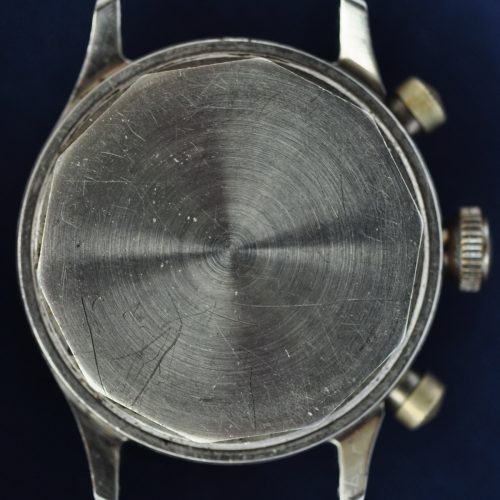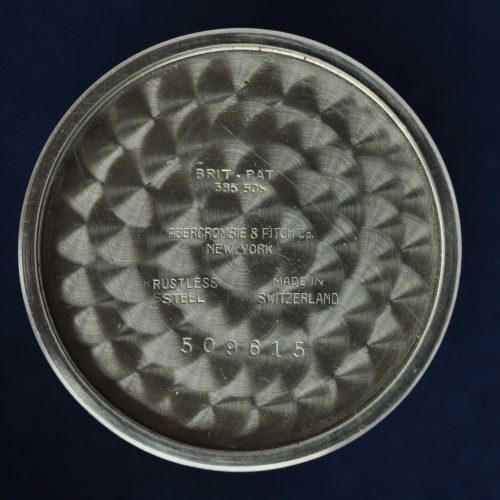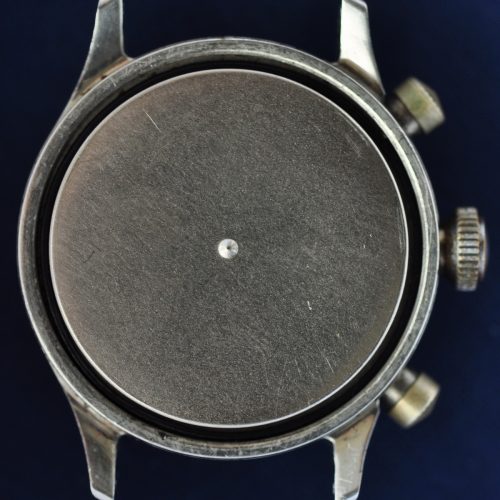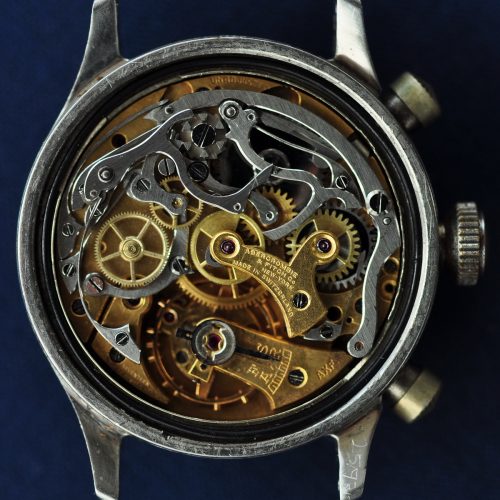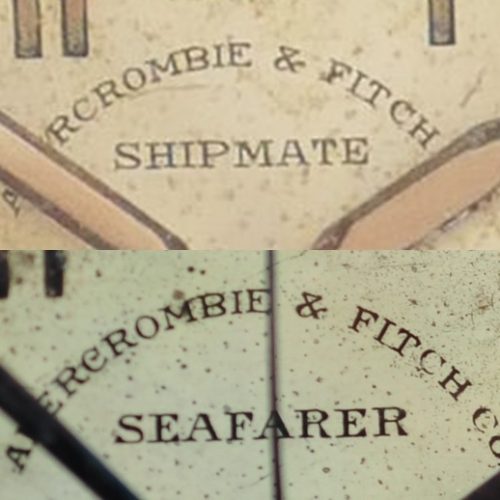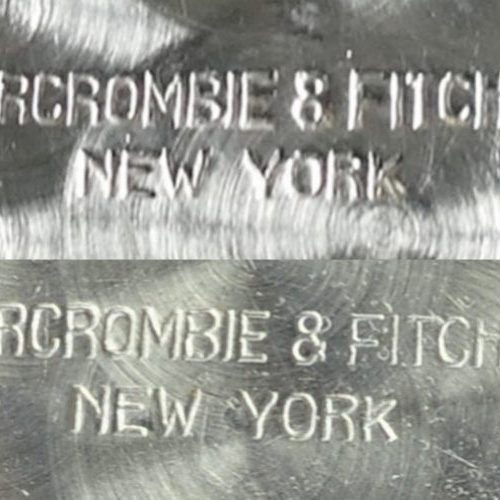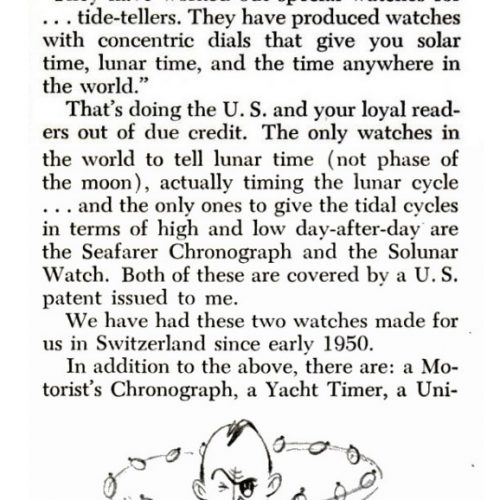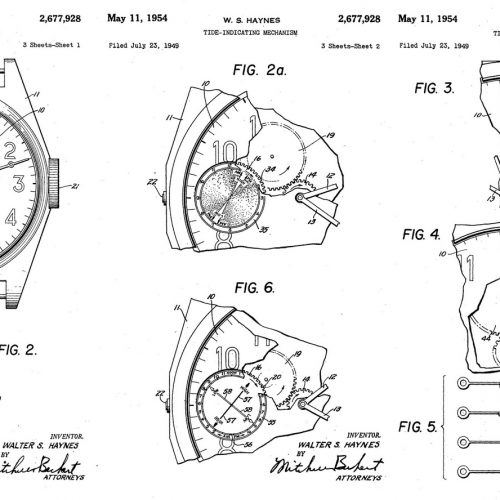In this guest posting, David Pearce tells us about his discovery of what seems to be the first model of Abercrombie & Fitch Seafarer chronograph, from the days before Heuer was making these watches for Abercrombie & Fitch.
The Abercrombie & Fitch Seafarer chronographs, with their distinctive ‘tide-indicator’ sub-dials, are already well known among collectors of vintage watches. In addition to this, due almost certainly to the Heuer connection and associated interest from the Heuer community, they are also very well researched. Technical details and a timeline of models (from the ref. 346 in the early 1950s, to the late 2446C references of the 1970s) can be found in this OnTheDash posting.
What was less well known, or perhaps even unknown until recently, was the existence of an earlier model of the Seafarer (without tide-indication) that probably dates from the late 1930s. This Seafarer was almost certainly produced by someone other than Heuer, but it still provides a great opportunity to research the early history of Abercrombie & Fitch watches and the suppliers involved.
Where it was found
One afternoon in the summer of 2016, whilst sensible people were out enjoying the sun with a barbecue and a beer, I was at home and hastily trying to research a watch that I had just spotted online. The available images were extremely low resolution, but there was just enough detail to figure out that it was a chronograph with a five-minute countdown timer, that it had a ten-sided case back, and that despite its apparently terrible condition it was worth investigating further.
At first the pixellated text on the dial appeared illegible, but after some thought I concluded that it was ‘Abercrombie & Fitch Co – Seafarer – Waterproof’. A quick email exchange with a very helpful Jeff Stein didn’t uncover what it was, but did give me enough confidence to go for it. A bid was duly placed, the watch was won, and a couple of weeks later it dropped through my letterbox. This is what arrived, and below is what I’ve learnt so far.
The Case, Crown, and Pushers
The 35mm mid-case is the same Borgel/Taubert mid-case used in the Mido Multichrono. Note that the Mido Multichrono is the predecessor of the more common Multi-Centerchrono, and uses a different case. A side-by-side comparison of the Mido Multichrono and the Abercrombie & Fitch Seafarer confirms that the Seafarer is housed in the Mido case. (The photo of the Mido Multichrono is courtesy of James Dowling and is used with his permission.)
As was the style of the Mido chronographs, the case bears the last four digits (9615) of the complete serial number (509615) between the lugs at six o’clock. This serial number dates the case to 1938 according to the archives at Mido. The five o’clock lug is roughly marked on the reverse with a reference number, but it isn’t clear whether this is a service mark, some kind of inventory number, or something else.
The caseback is of the standard ten-sided Multichrono design, but with two variations. Firstly, the exterior of any standard caseback should be stamped with a large amount of text around the perimeter. This text stated the manufacturer (Mido), the model (Multichrono), the country of origin (Switzerland), and further details extolling the virtues of what was a cutting-edge case at the time (Waterproof, Impermeable, Anti-Choc, Shockproof, Antimagnetic, and Rustless Steel). In contrast, the caseback of this Seafarer is completely devoid of markings.
It is possible that it was originally produced unmarked, but the lack of any chamfer and the presence of light concentric circles seems to indicate that markings were present but subsequently machined off. This could probably be confirmed by comparing the thickness of a standard Multichrono caseback against the 0.52mm thickness at the centre of the Seafarer caseback.
Secondly, there are additional markings to the inside of the Seafarer caseback. The interior of the standard Multichrono caseback is only marked with the serial number and a reference to British Patent No. 385509 which was accepted in 1932. The Seafarer caseback bears the same text in the same position, but also the further text ‘Abercrombie & Fitch Co. New York, Rustless Steel’ and ‘Made in Switzerland’.
Interestingly, the Abercrombie & Fitch text appears to be identical, in both font and size, to the Abercrombie & Fitch text found in at least some of the Shipmate models.
It is often hypothesised that Mido produced the Shipmate for Abercrombie & Fitch (mainly due to the visual similarities between it and the contemporary Mido Multiforts), but no hard evidence has ever been put forward. Mido themselves also state that there are no records of any collaboration between the two companies, but their archives are apparently incomplete for this period so ‘no record’ cannot conclusively prove no collaboration. Two other points to note are the presence of what appears to be a hand-scribed service mark (16027), and a hand-stamped attempt to write ‘Rustless Steel’ prior to the final markings.
The sunburst pushers are of the standard Borgel type found on the Multichrono, and the oversize crown is also considered correct for the period although not of a type found on known Multichronos. Both crown and pushers would be functionally perfect for a chronograph designed for use in a wet environment.
The Movement
The movement is a modified version of the Minerva cal 13-20 which was the calibre used by Mido in the Multichrono. The 13-20 came in two versions, one with 30 minutes per complete revolution of the subdial and one with 45 minutes per complete revolution. All Multichronos were fitted with the latter version, but in order to achieve the 5-minute countdown the Seafarer movement utilised a 30-minute minute counter. This works in conjunction with a modified centre seconds wheel, which has six fingers attached instead of the typical one. This converts the right-hand sub-dial from a 30-minute counter to a 5-minute counter. Each passing finger causes the subdial minute counter to step forward by 12°, so one full rotation of the centre-second hand (one minute) will give 72° of rotation in six small steps, and in five elapsed minutes the subdial minute counter will make one complete 360° sweep.
The movement arrived with significant water damage which probably occurred quite early in the life of the watch due to the relatively good condition of the case. The serial number 1484783 dates the movement to 1938/39, which matches well with the case date of 1938. The closest known serial number of a 13-20 movement in a surviving Multichrono is 1484907 (only 124 later), and this was fitted in a Mido case numbered 509645 (only 30 later).
The level of finishing on the original chronograph levers was low, with no polishing or bevelling, which is completely typical of the ebauche 13-20 movements fitted to all Multichronos. At the time of the repairs the connection between the Seafarer and the Multichrono had not yet been established, and the priority at the time was a working watch.
Due to the water damage the watch was essentially unrepairable with entirely original parts. Fortunately, all the original plates, bridges, and cocks were usable, so the identity of the original movement could be maintained. This was considered important as all the movement plates are stamped with the reference number 11 so they are a matched and original set. The original bridge is signed ‘Abercrombie & Fitch’ and the associated US import code (AXF) is stamped on the balance cock. A donor movement was still required to provide parts where the originals were unsalvageable. The selected donor movement came from a 1944 Minerva chronograph and was finished to a higher standard, so the repaired Seafarer movement now contains polished and bevelled levers. With hindsight I would have held out until an unfinished donor movement from a Multicrono could have been sourced.
The Dial and Hands
The front of the dial was covered in a thick layer of dirt, having spent decades floating around in a watchmaker’s drawer with no crystal installed. The font and style of the dial text is comparable with other late 1930s models, as in the example below when compared against a contemporary Abercrombie & Fitch Shipmate.
The consensus is that the lume dots on the hours, and the lume applied to the tips of the hour and minute hands, are later additions. The original centre-seconds hand was missing, so the watch was fitted with the seconds hand from the 1944 Minerva donor watch.
The dial back is marked with the ‘Z.J.’ logo which identifies the producer as Z.J. Flückiger from St. Imier in Switzerland. Flückiger supplied dials to a number of manufacturers, including Mido, and Flückiger are known to have produced dials for the Multichrono models. It is also marked on the reverse with the reference no. 0 7674, but unfortunately Flückiger were unable to provide any information on the dial as they do not have archive material from this period.
The Seafarer Trademark
The trademark application on the ‘Seafarer’ name was filed by ‘Abercrombie & Fitch Co., NYC’ on April 9, 1949 but it indicated that the first use of the Seafarer name was almost twenty years earlier on March 30, 1930. The following image from the United States Horological Trademark Index, by Kurtis Meyers, also indicates the March 30, 1930 date, for Abercrombie’s first use of the Seafarer name.
This confirms the existence of Seafarers before the tide-indicator versions produced by Heuer and suggests even earlier Seafarer branded timepieces may have existed due to the 1938 case and 1938/39 base-movement on this Seafarer. Given that the filing date was less than a year before the first tide-indicator watches hit the market, it seems reasonable to assume that the trademark was filed as the collaboration with Heuer was in its final pre-production stages.
Related to this is the filing by Walter S. Haynes, the President of Abercrombie & Fitch, for a patent on a “Tide Indicating Mechanism” on a watch, in July 1949. This patent would be used for the Solunar watch, made by Heuer for Abercrombie & Fitch. This type of tide indication dial was also used in the Seafarer chronographs, introduced by Abercrombie in the early 1950s.
A little historical context (and a lot of speculation!)
There are still more questions than answers, but three interesting facts were uncovered whilst trying to research the history and background of the watch.
Popular Science Journal
In the July 1955 edition of Popular Science, Walter S. Haynes (the then vice president of Abercrombie & Fitch) wrote a letter to the editor commenting on an article in the May edition about the Swiss watch industry. In his letter, amongst other things, Haynes refers to a yacht-timer which Abercrombie & Fitch had developed. Of course, Abercrombie & Fitch had produced stop-watch format yacht-timers from the early 1940s onwards, but perhaps this Seafarer wristwatch could be the yacht-timer referred to by Haynes.
As an aside, the short but fascinating letter also refers to a motorist’s chronograph (most likely the Auto-Graph), a universal stopwatch (perhaps the Heuer Ring-Master which has been seen co-branded with Abercrombie & Fitch), two special diver’s watches (maybe the mysterious Sub-Sea and Deep 17 which Abercrombie & Fitch trademarked just months earlier in January and February 1955), and a poor-man’s chronograph (whatever this might be).
Harry Haskell’s Racing Yachts
In 1950 Harry Haskell (the then owner of Abercrombie & Fitch) commissioned the racing yacht ‘Nirvana’, a 65-foot yawl specifically designed to compete in the Bermuda race. Unfortunately for Haskell ‘Nirvana’ was completed only one week before the race started, leaving no time for trials and development, and she finished near the back of the field. In 1953 she was sold by Haskell to Nelson Rockefeller. A sister-yacht to ‘Nirvana’, named ‘Valhalla’, was also commissioned by Haskell. Later, in 1956, Haskell had the 73-foot ‘Venturer’ built to again compete in the Bermuda race, this time coming second behind another 73-foot yawl named ‘Bolero’. Perhaps this yacht-timer saw service with the captain and/or crew of one of Haskell’s racing yawls.
The Minerva Boardroom
Finally, according to an old Telegraph article on the rebirth of ‘Minerva’ (under the ownership of Montblanc):
In the boardroom at Villeret, amid the various displays on Minerva’s history is a vitrine showing the different brand names appearing on Minerva dials – the name that caught my eye being that of Abercrombie & Fitch from the era when they rivalled Brooks Brothers as the arbiters of East Coast style.
Minerva are known to have supplied Abercrombie & Fitch, but until now my research has uncovered no other Minerva-based Abercrombie & Fitch watches. Perhaps this Seafarer is the single connection between Minerva and Abercrombie & Fitch. The old Minerva factory in Villeret, which is now part of Montblanc’s watchmaking operations, searched their archives but unfortunately could not provide any additional information related to this movement or case.
So where does this leave us?
Much like the watch, there are statements and conclusions in this review that may not be completely watertight. As there are no archive records available at any of the identified suppliers (Mido, Minerva, Flückiger) we are only left to speculate with the available evidence. My best guess is that the Seafarer was produced as a prototype by Mido (or alternatively the producer of the Shipmate if that wasn’t Mido), with the intent that it would become a production model to be retailed by Abercrombie & Fitch. This was probably during the late 1930s or early 1940s, and perhaps the outbreak of war, or the start of American involvement, forced the project to go on hold. After the war ended, the strong relationship between Heuer and Abercrombie & Fitch began, and this yacht-timing Seafarer project perhaps gave way to the Heuer Seafarers with tide-indication dials.
Thanks for the Help
Whilst researching the watch I received invaluable support from a number of collectors, and I would like to thank in no particular order: Jeff Stein; Eric Wind; Omega forums — Northernman, Modest-Proposal, Syrte and VintageChrono; PuristSPro forums — Dr. Magnus Bosse, moderator at PuristSPro.com; and Watchmaker Robert Horan MBHI. Thanks also to the heritage / archive departments at Mido, Fluckinger and Minerva (now part of Mont Blanc).
